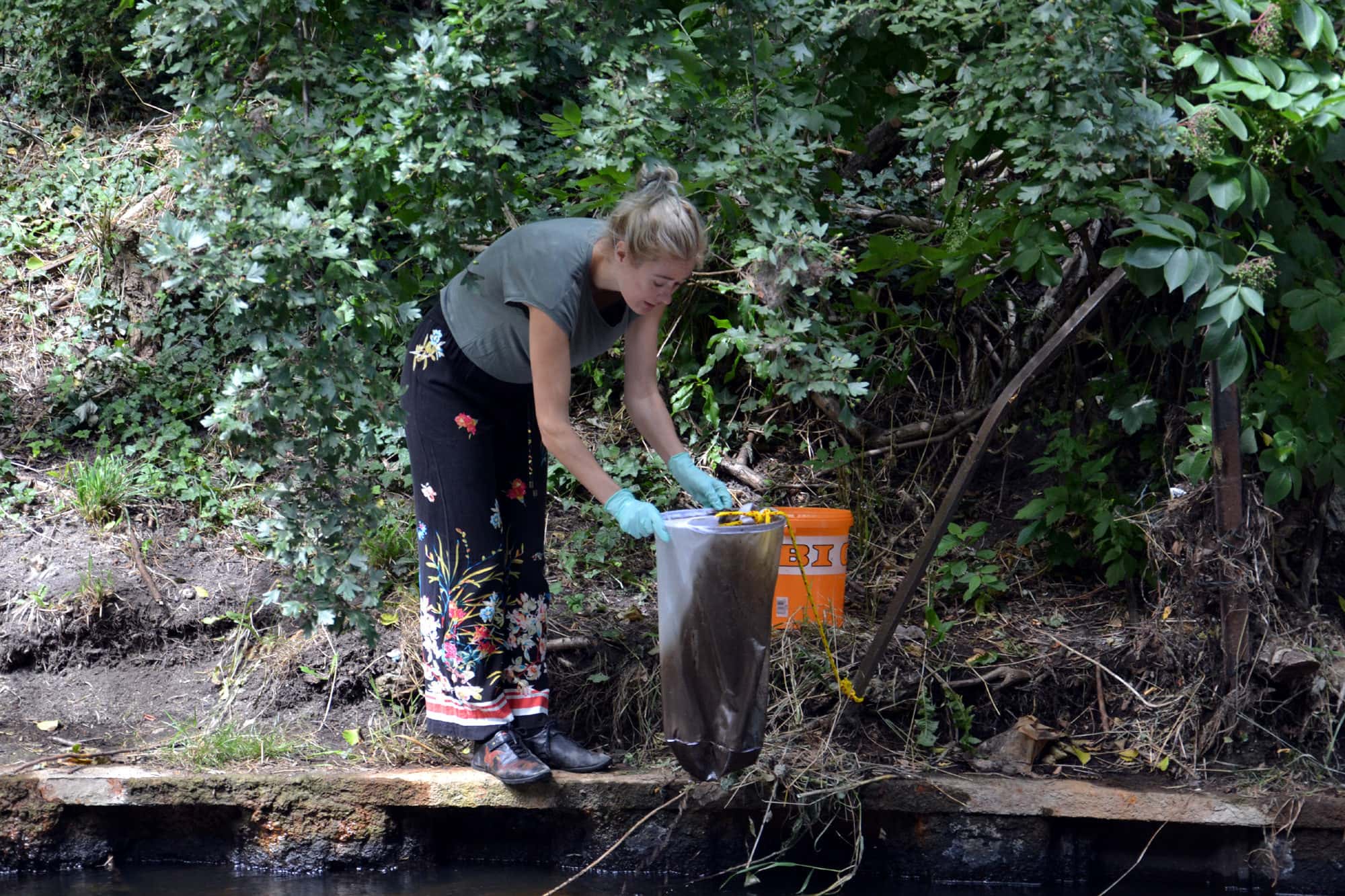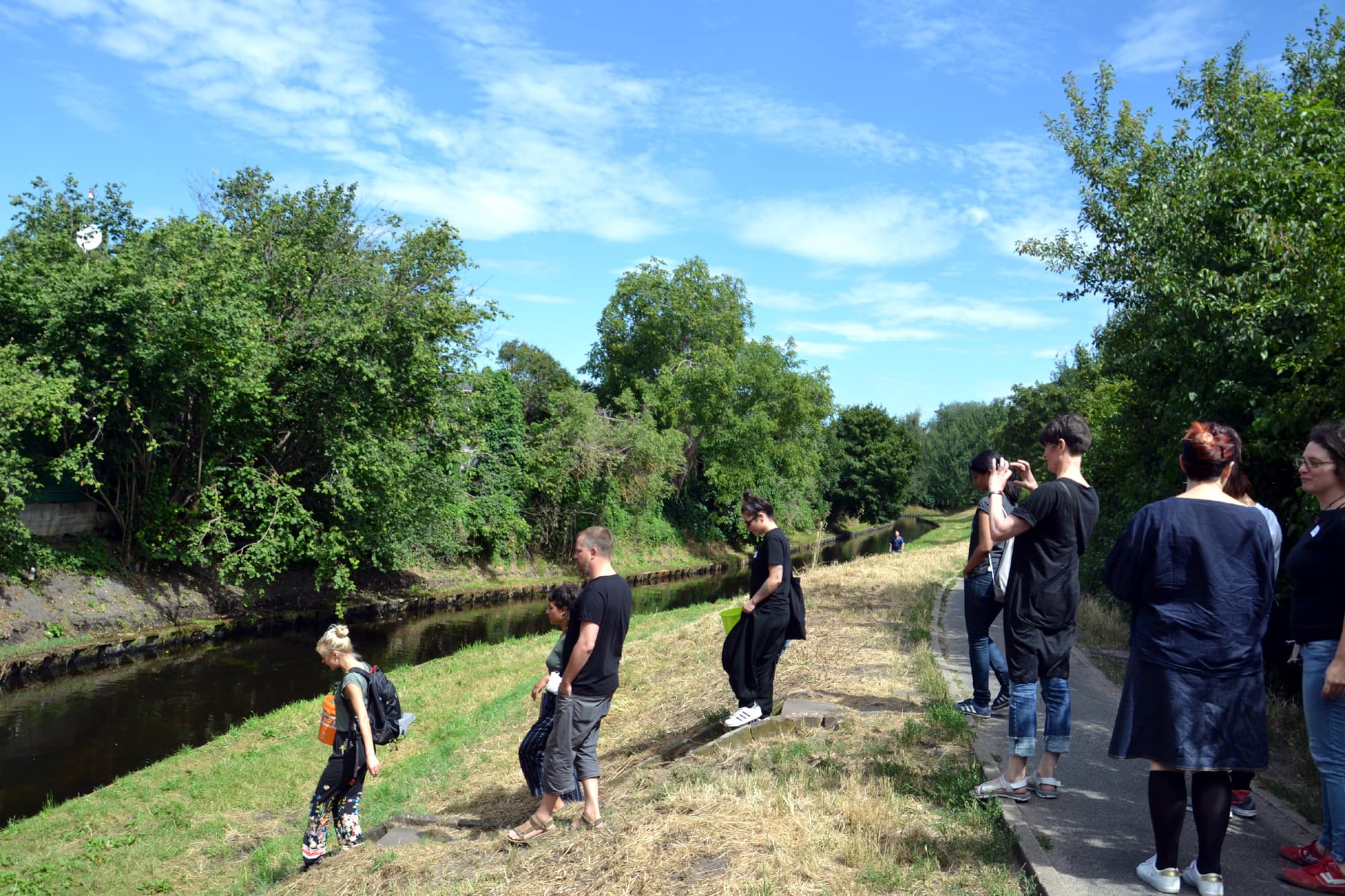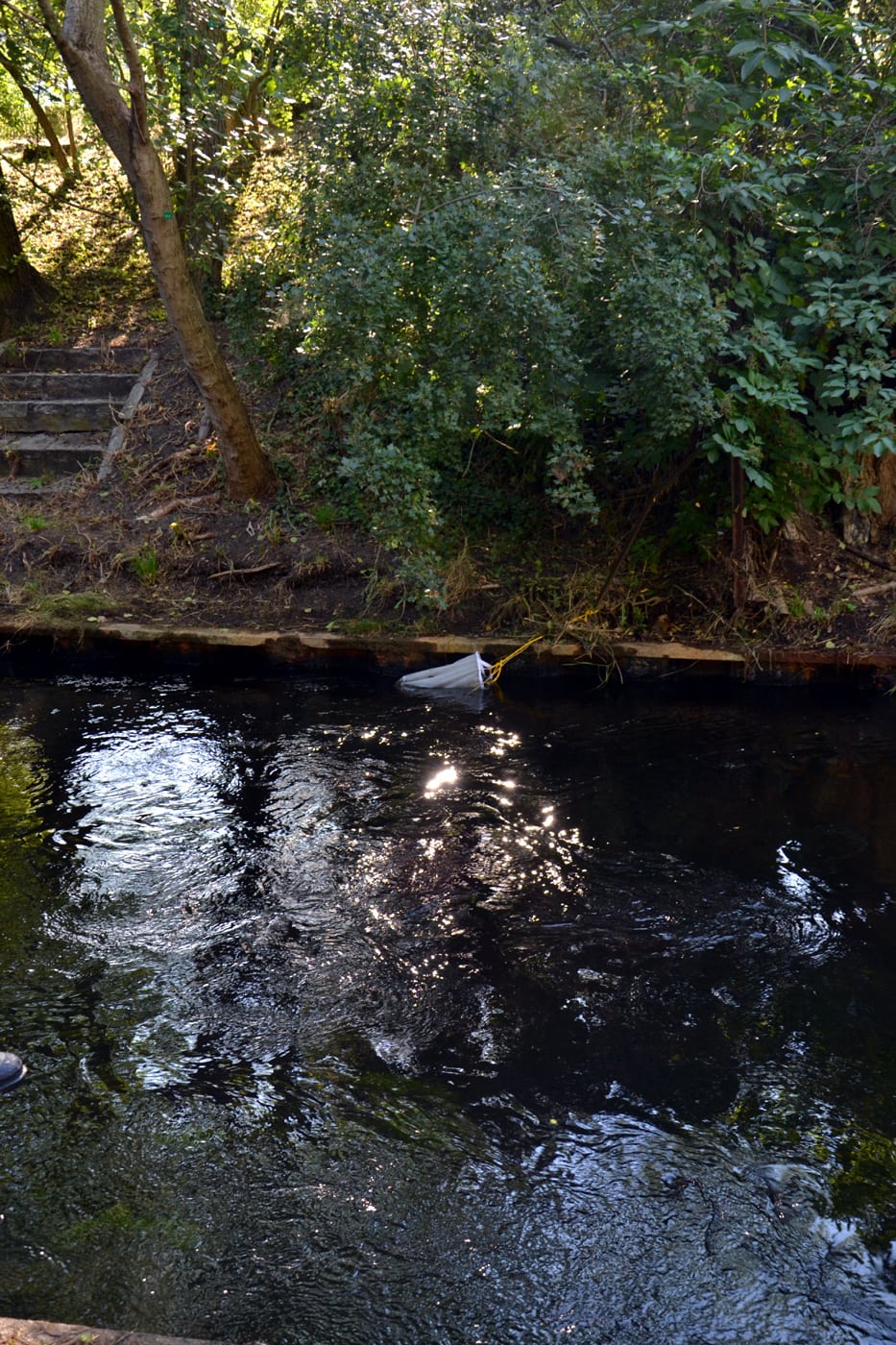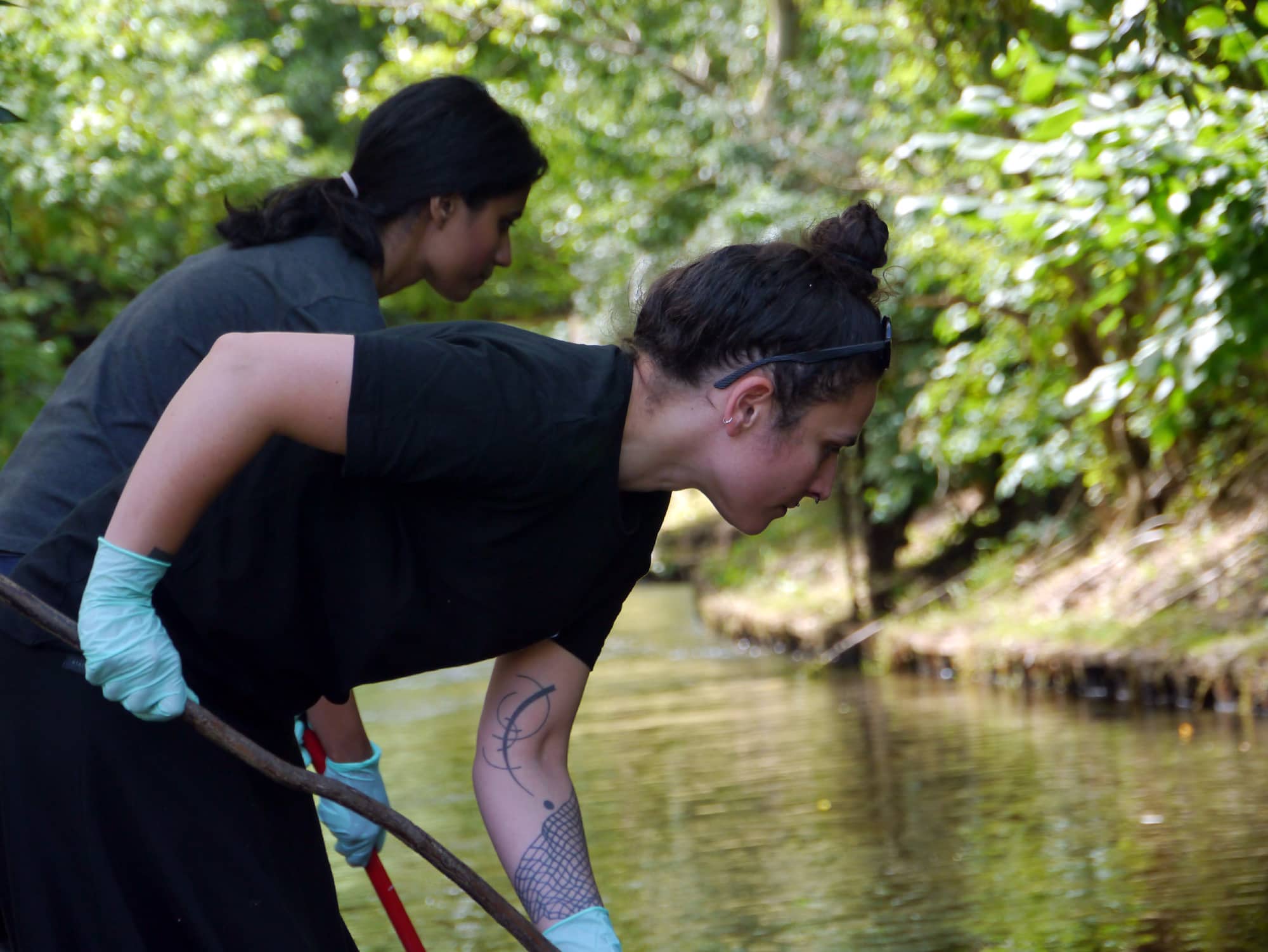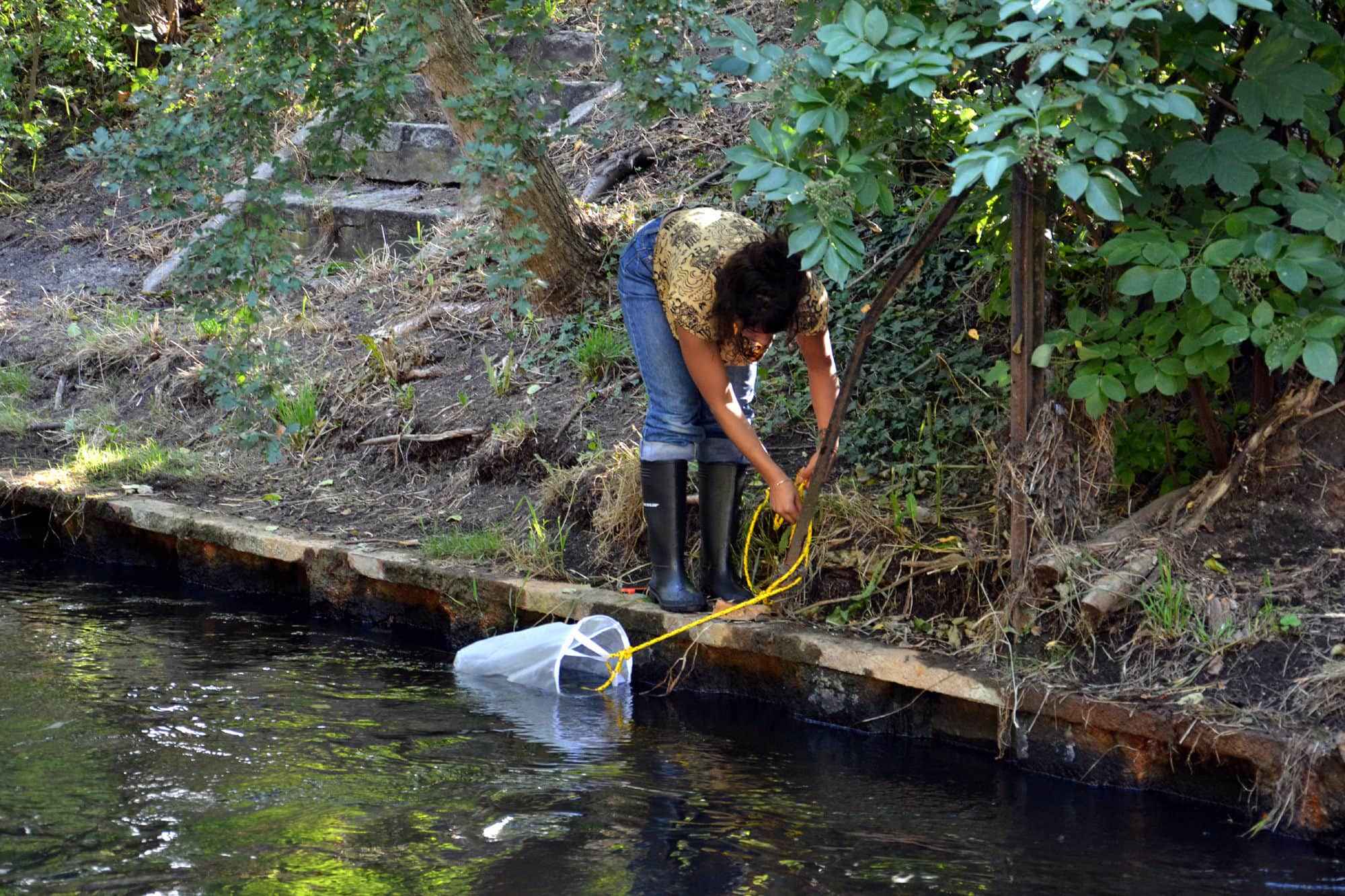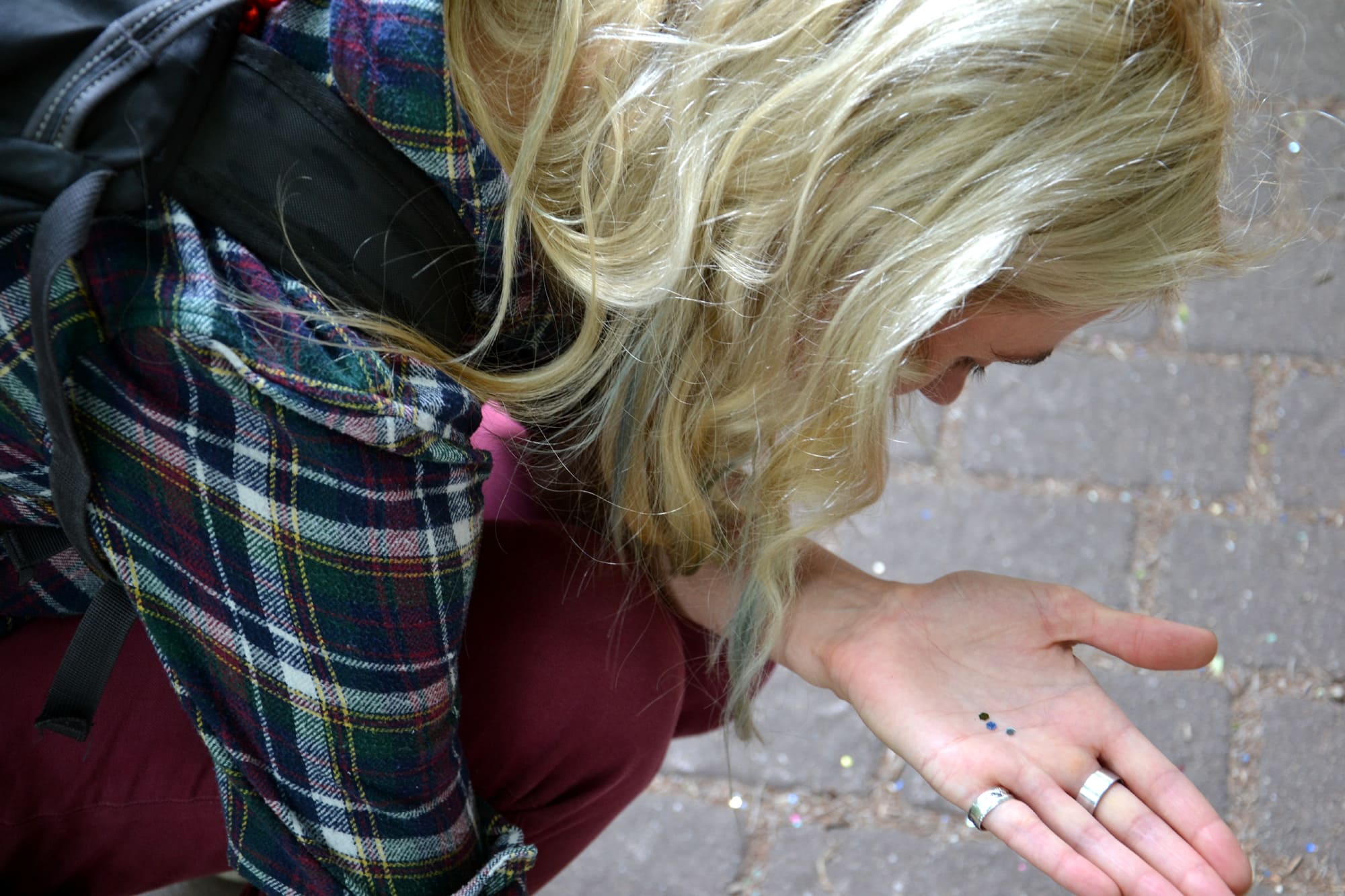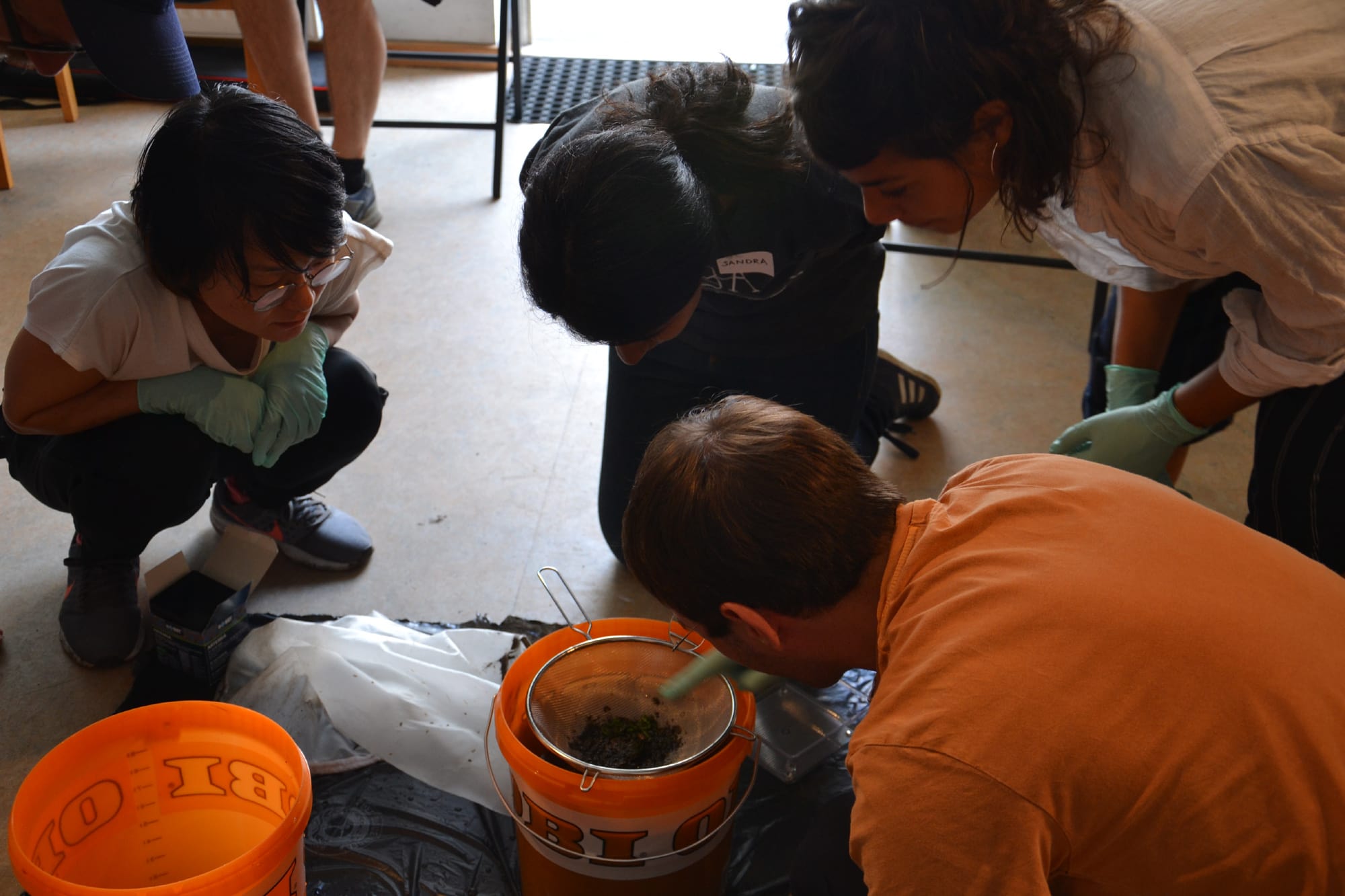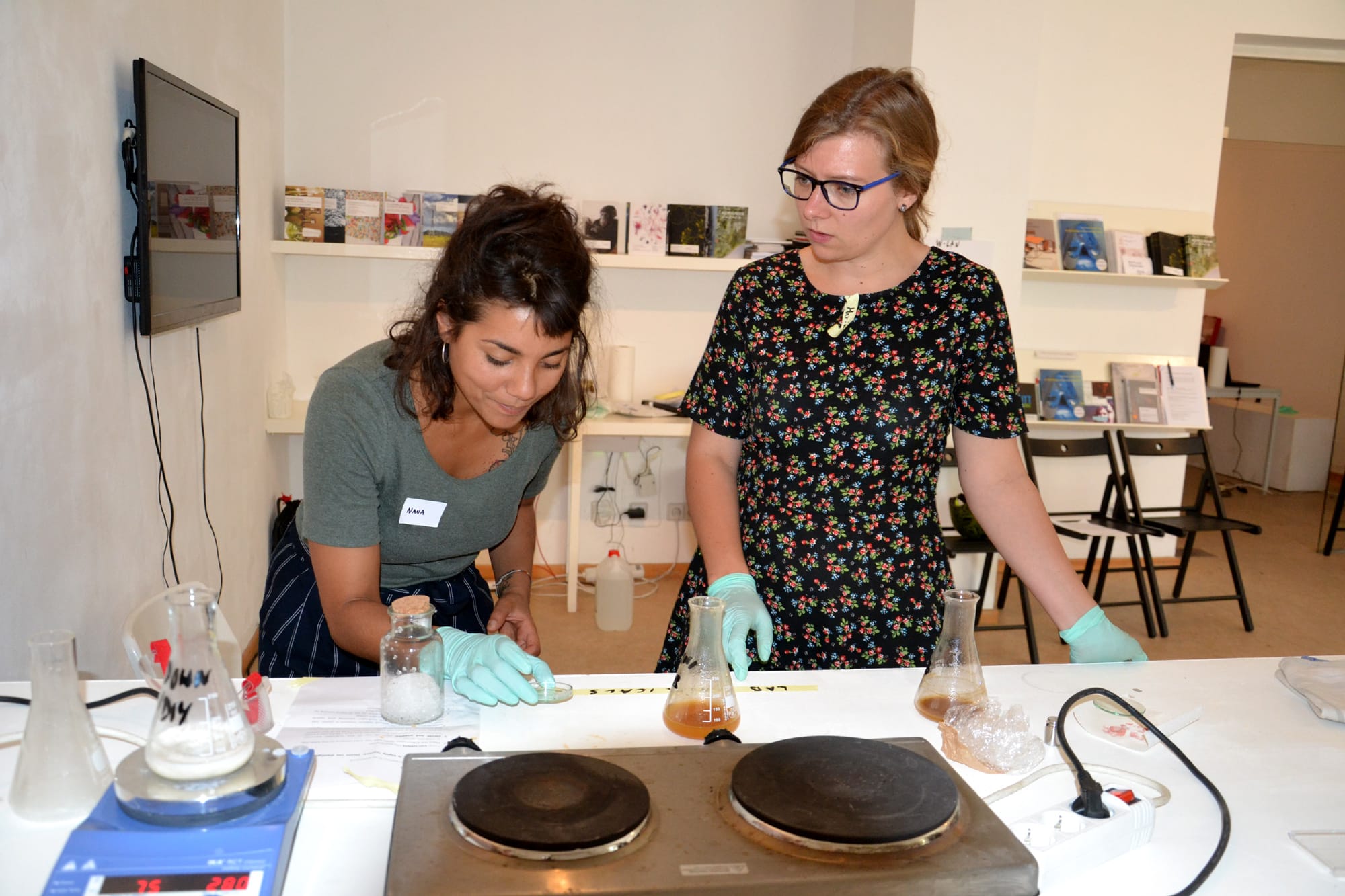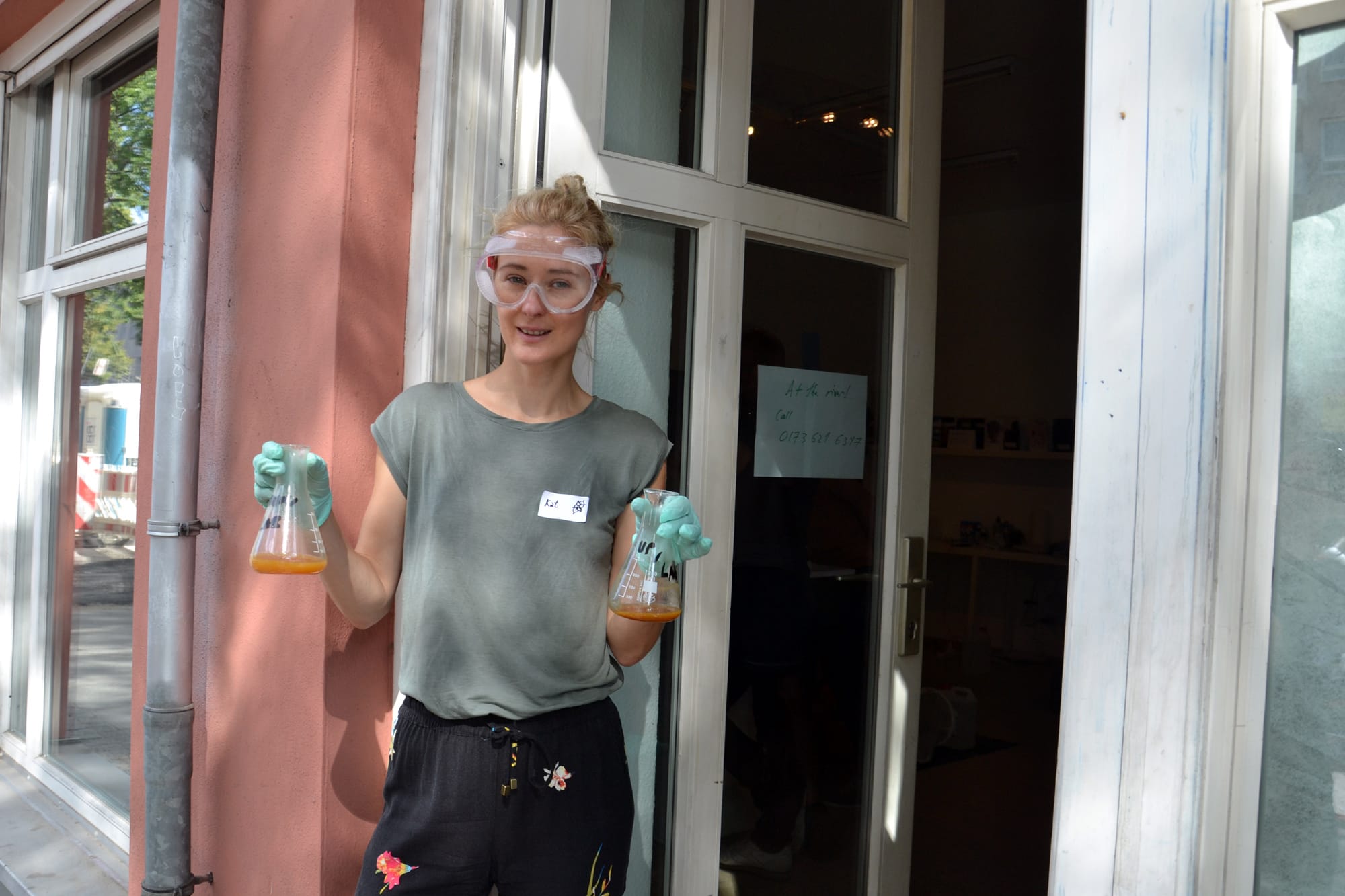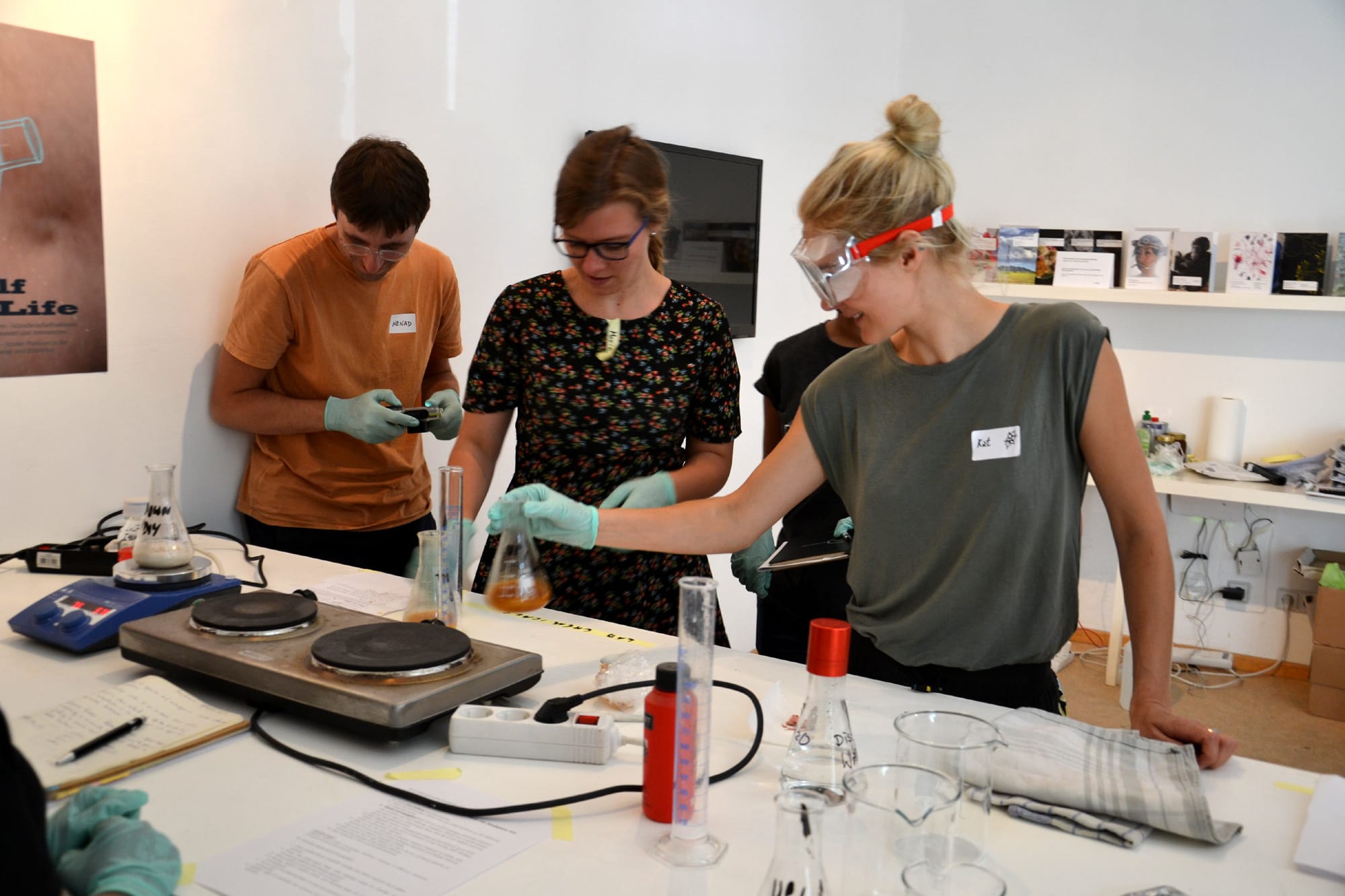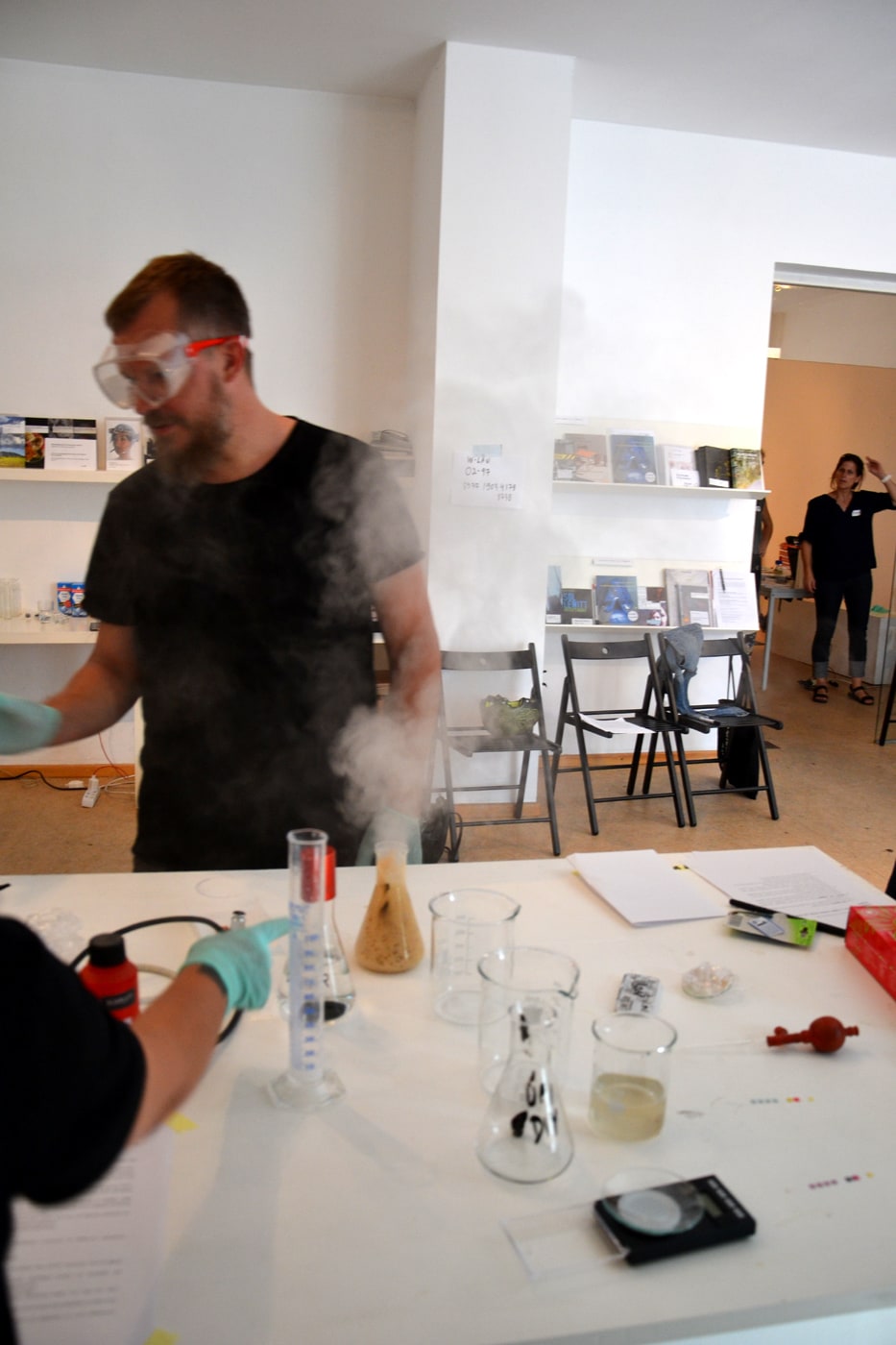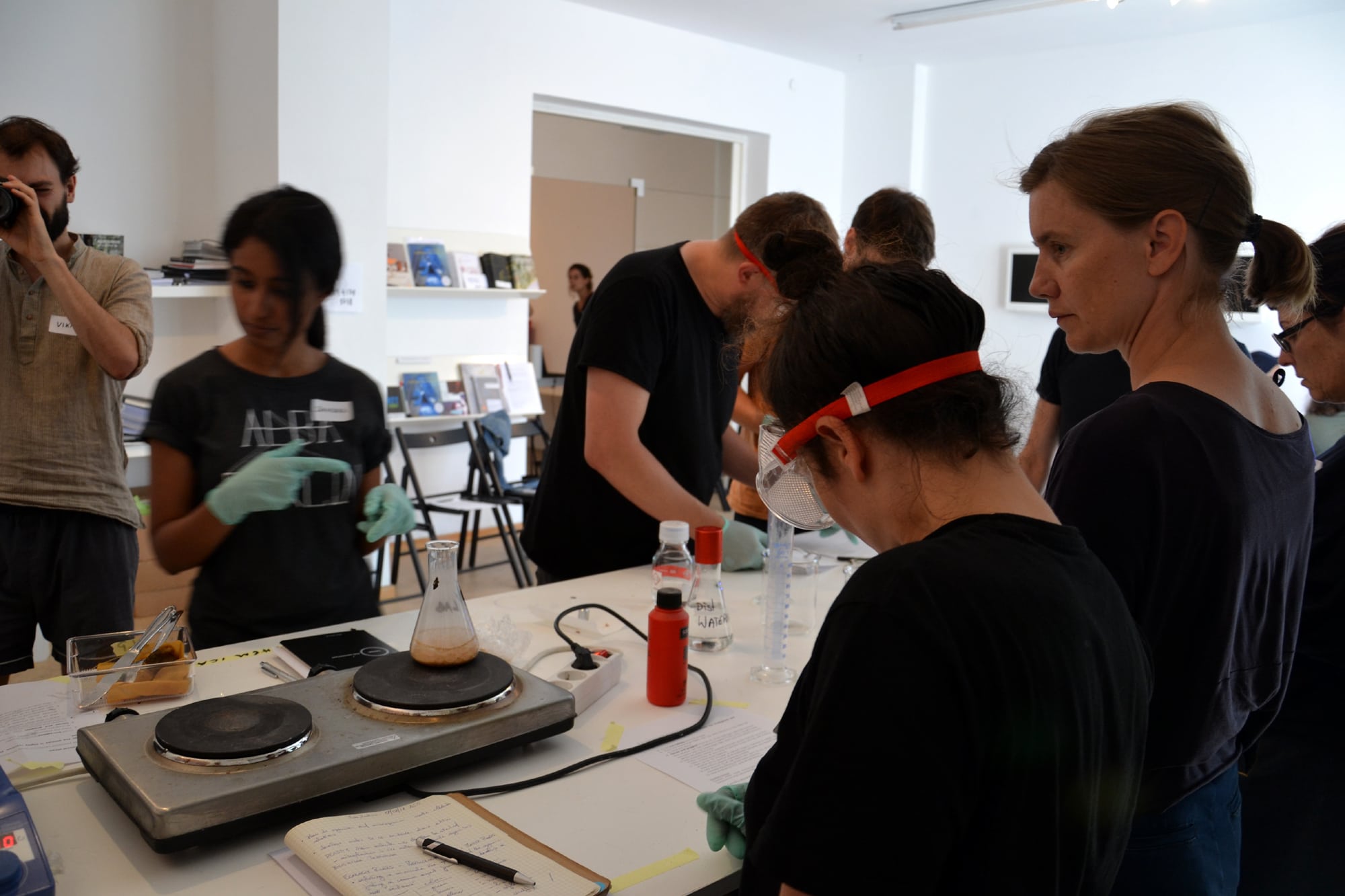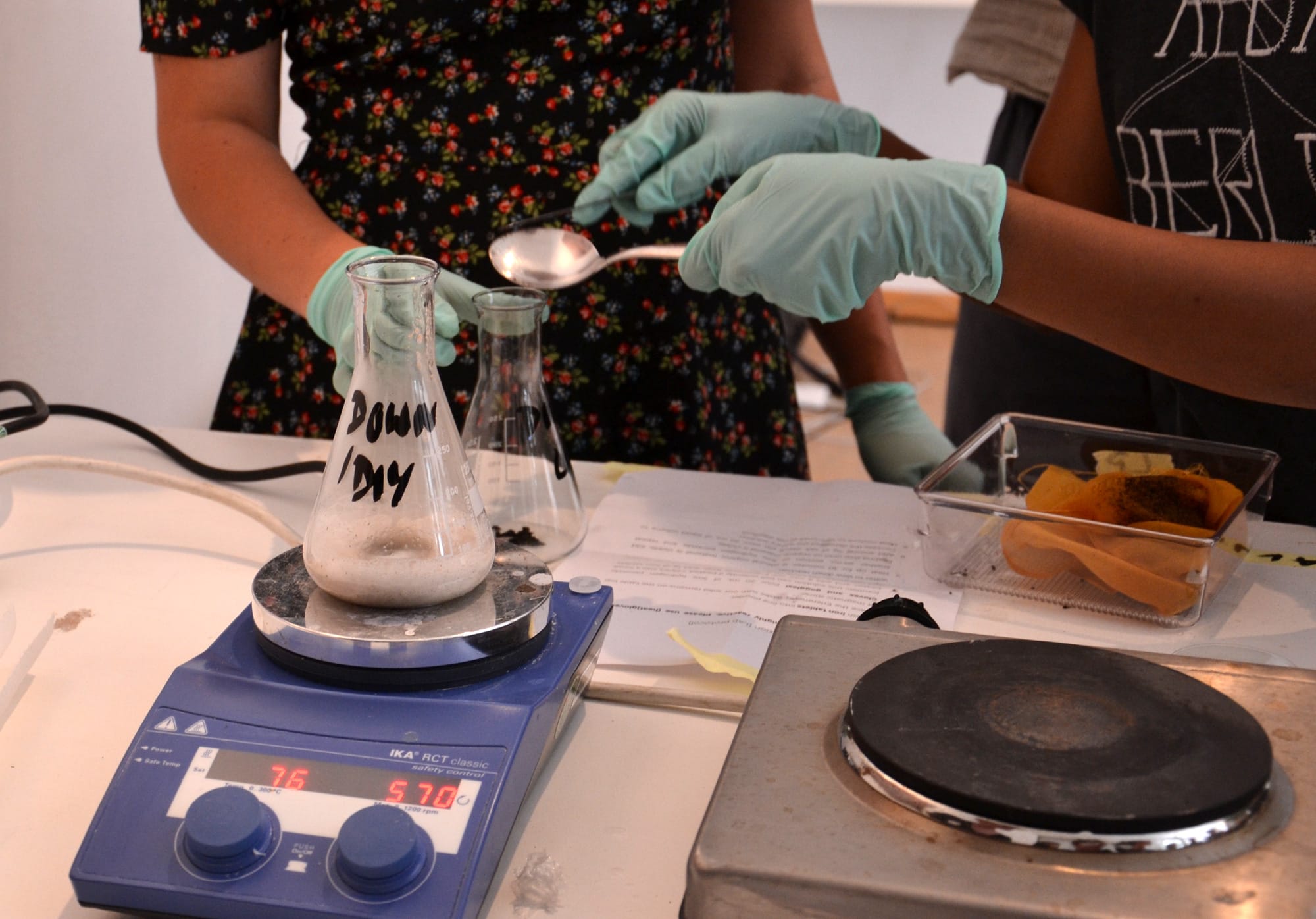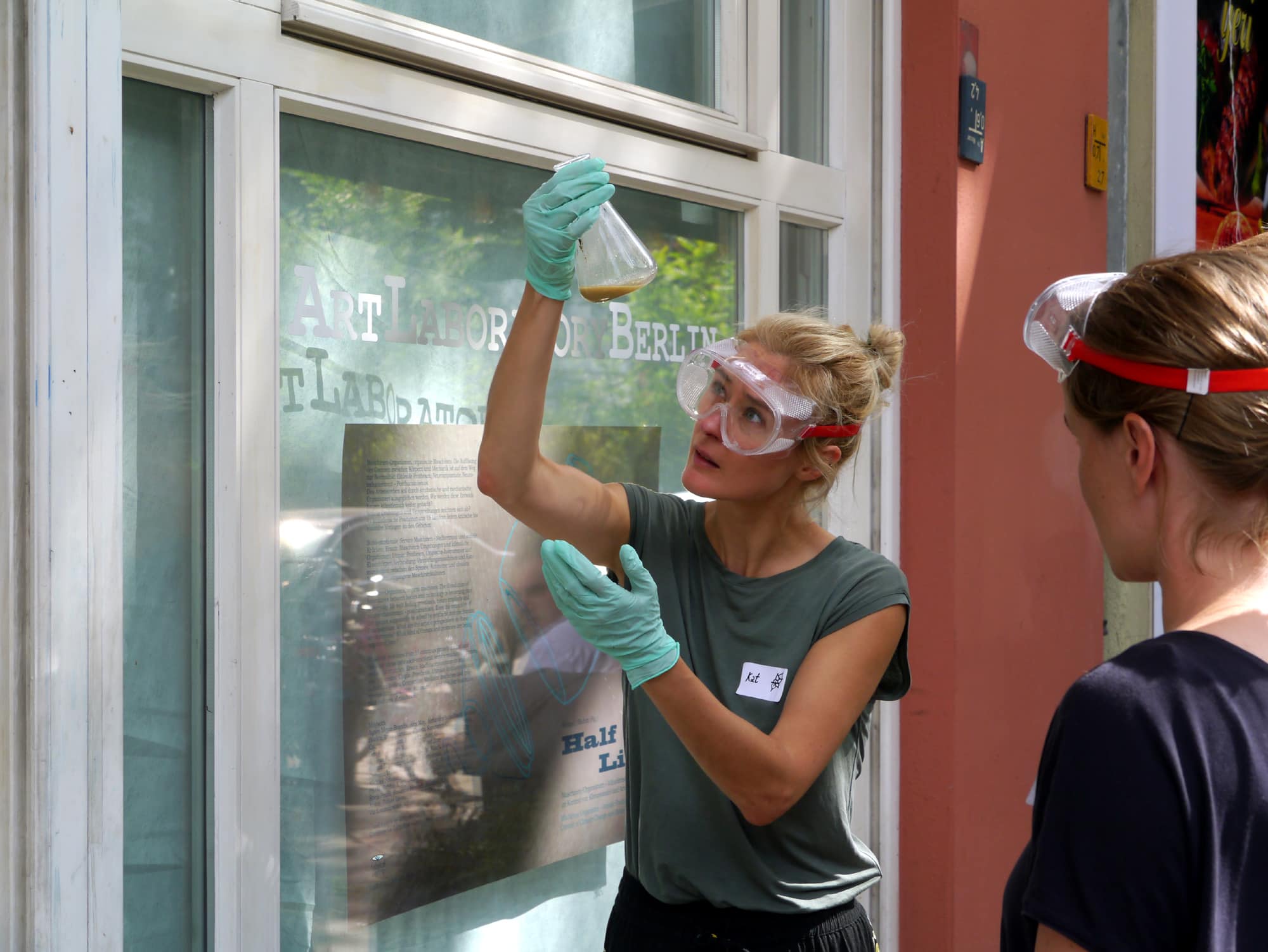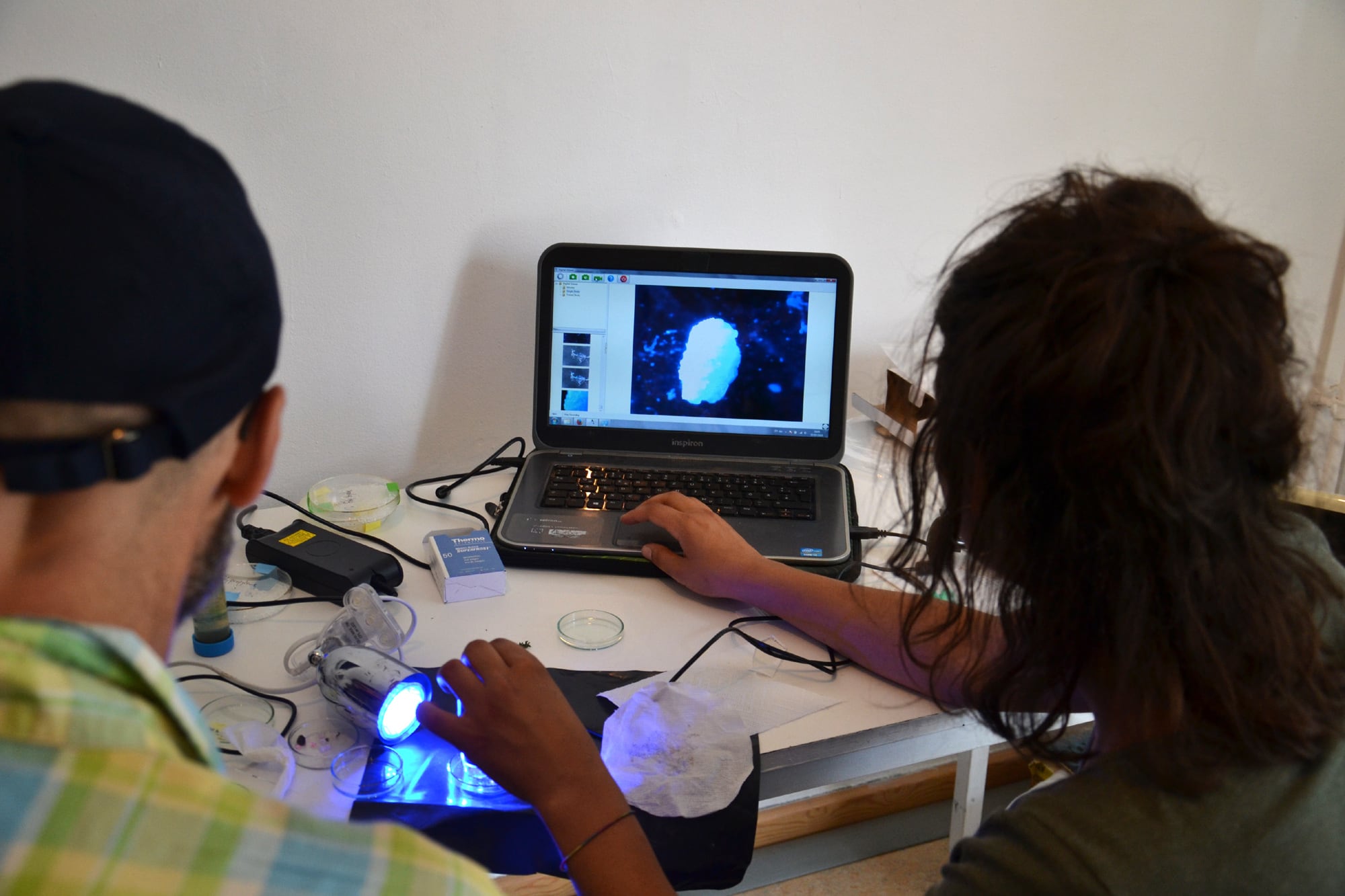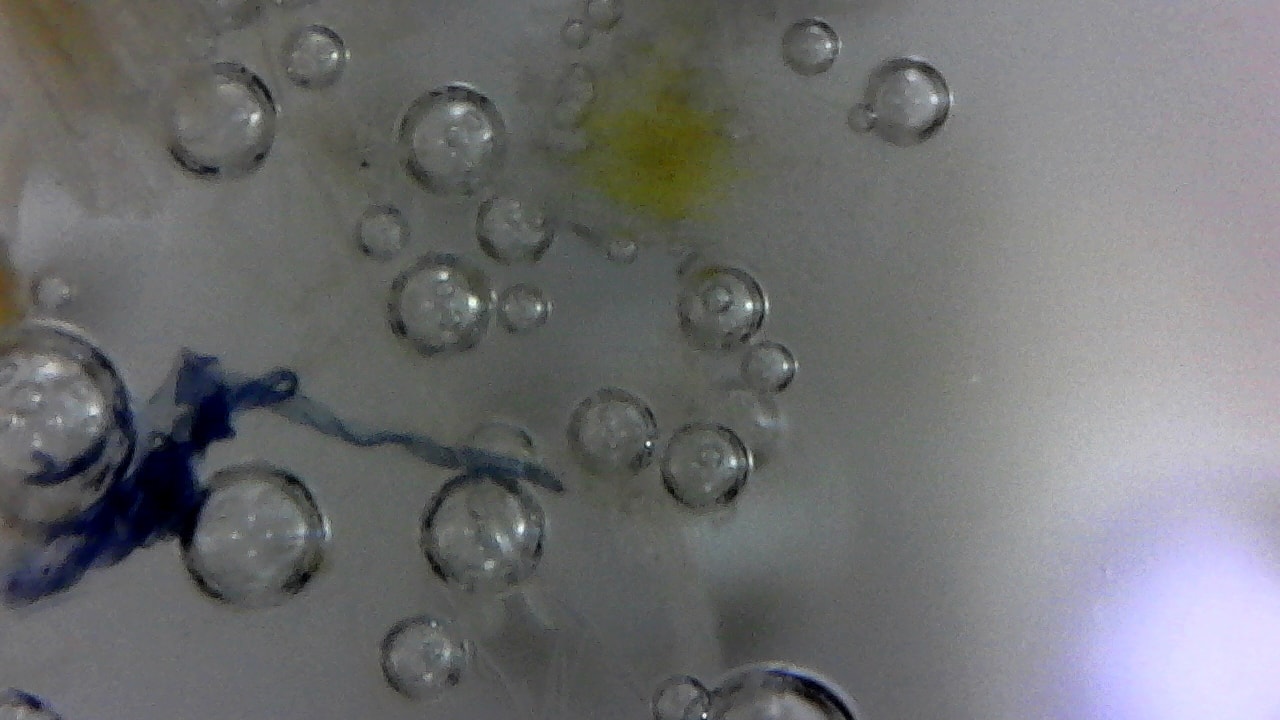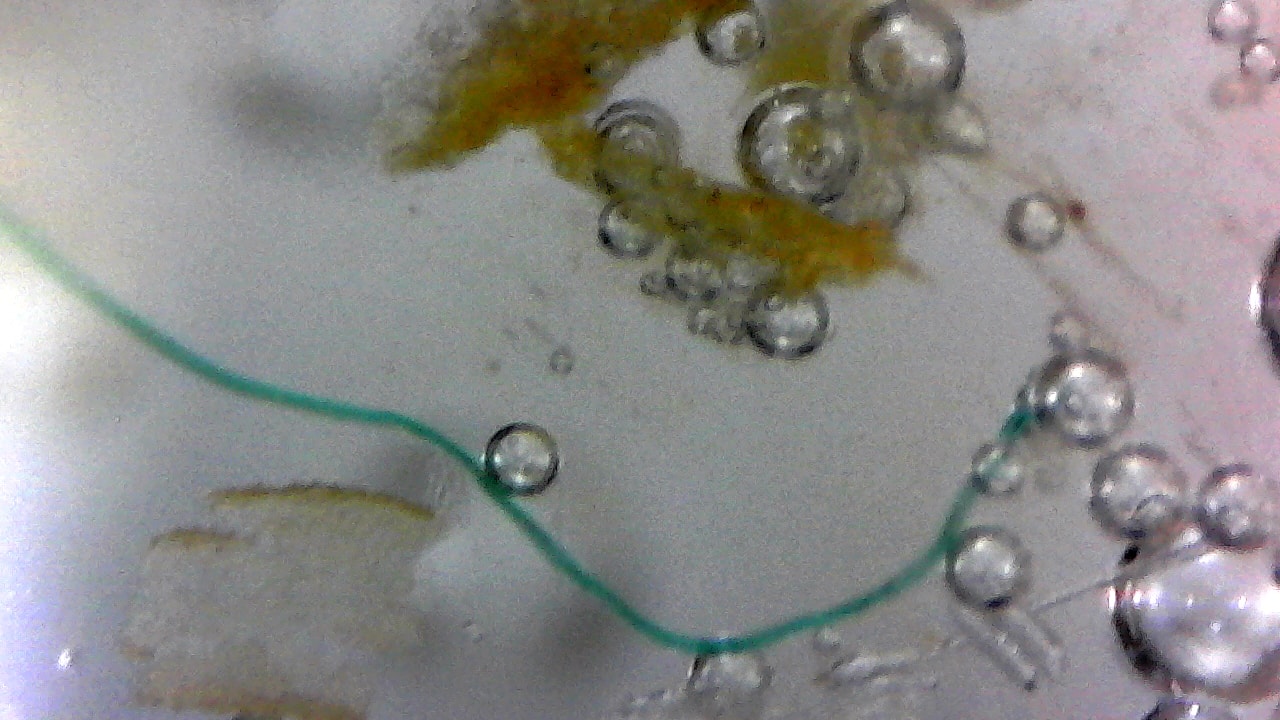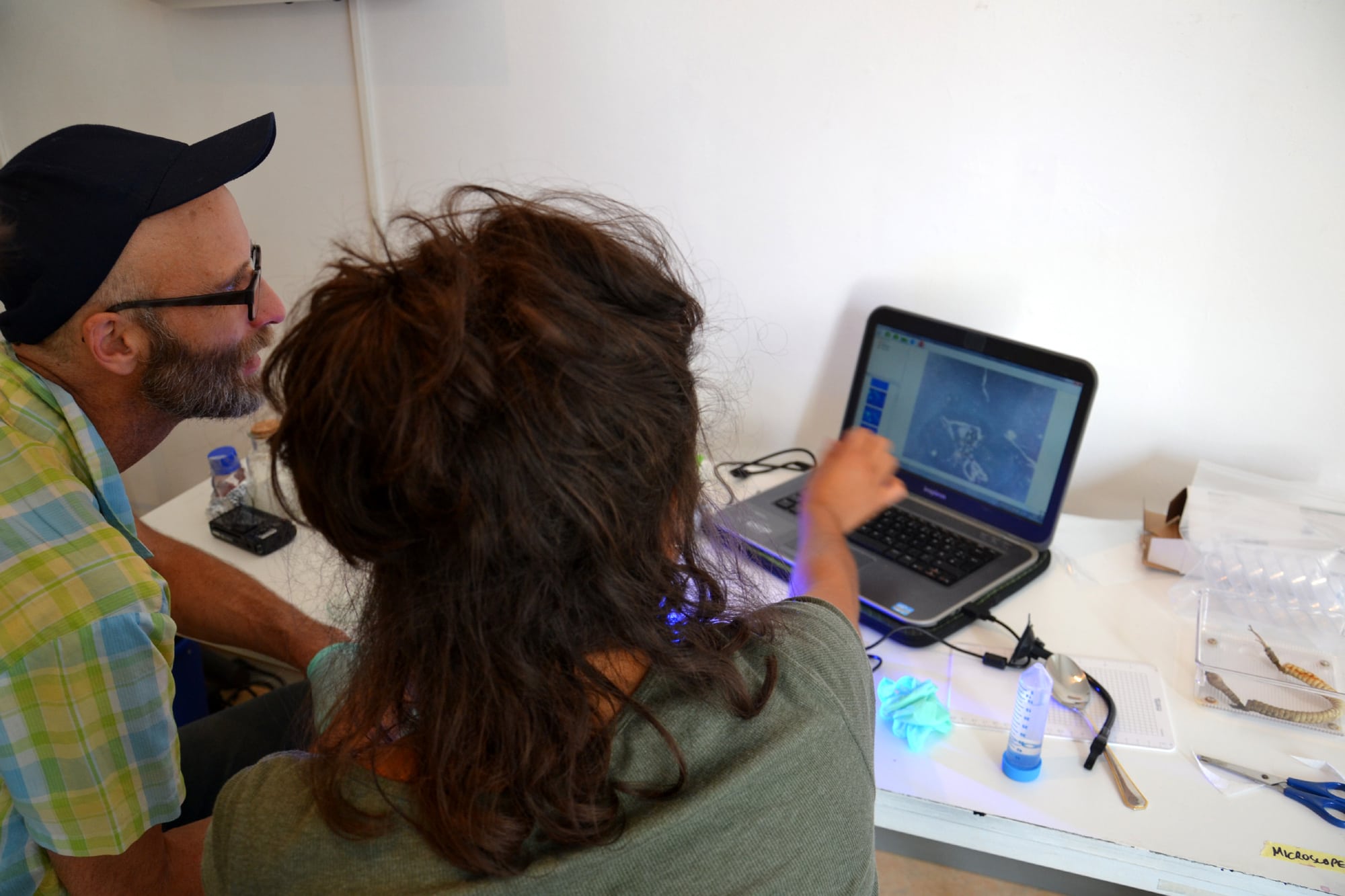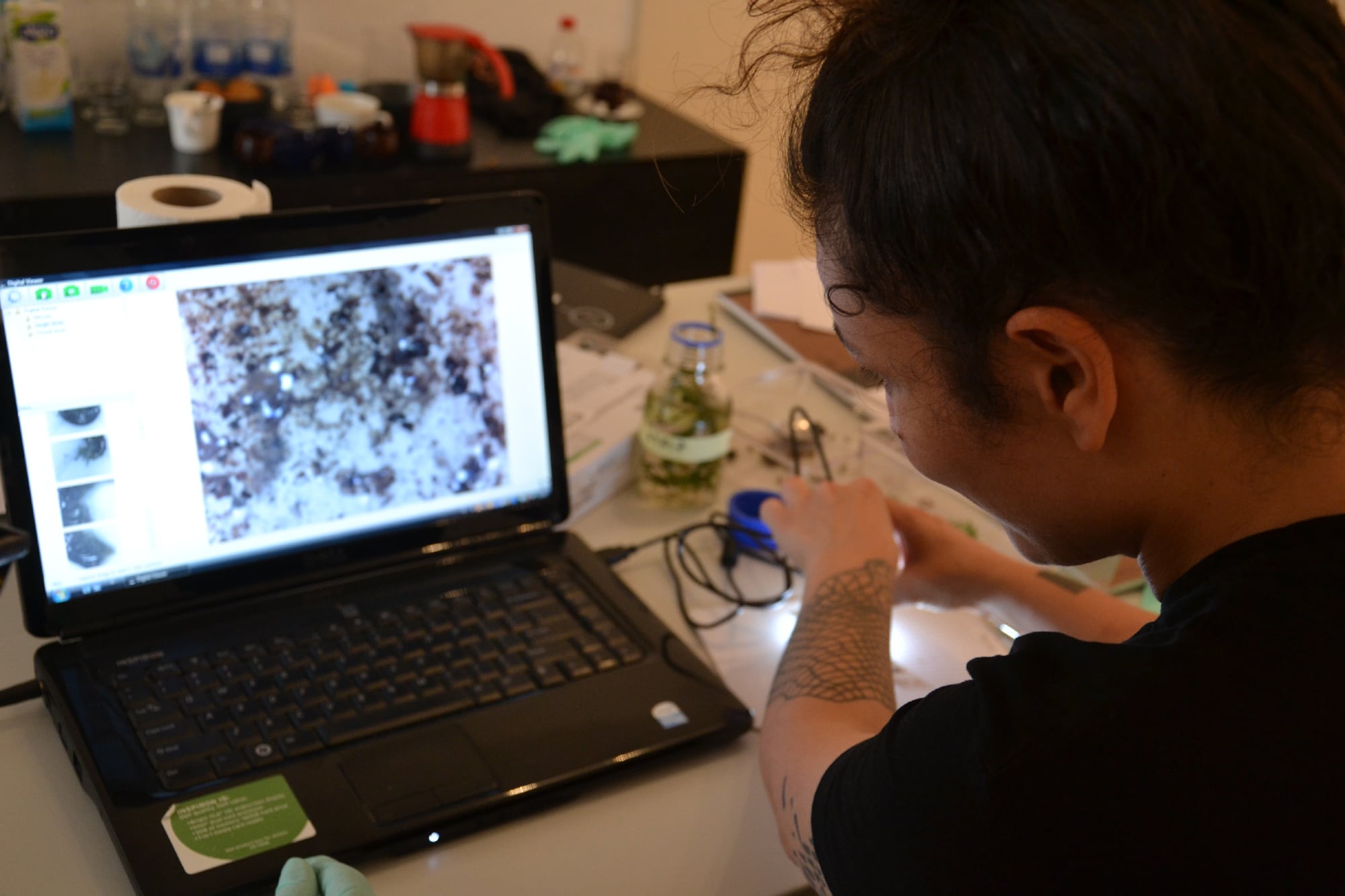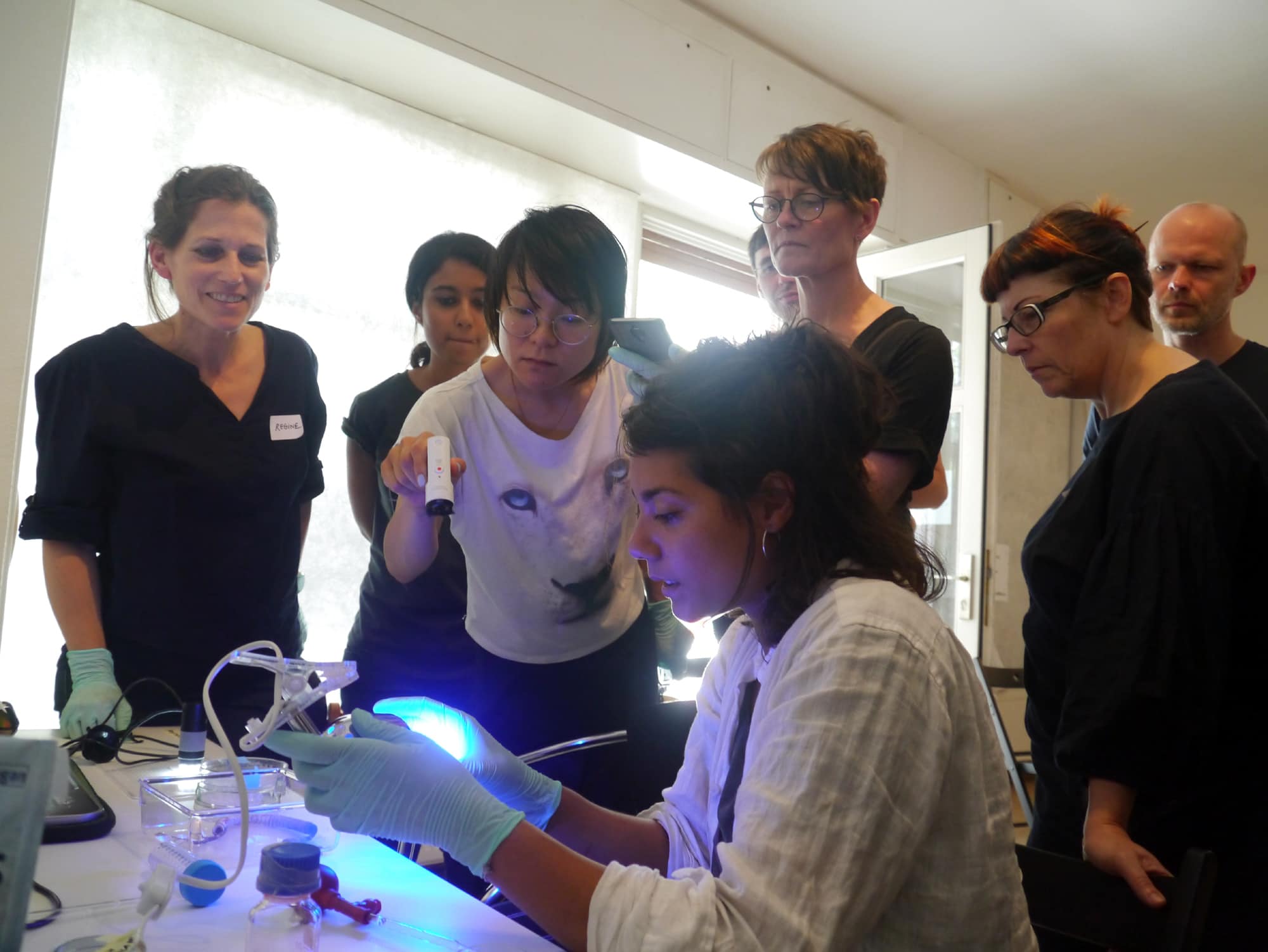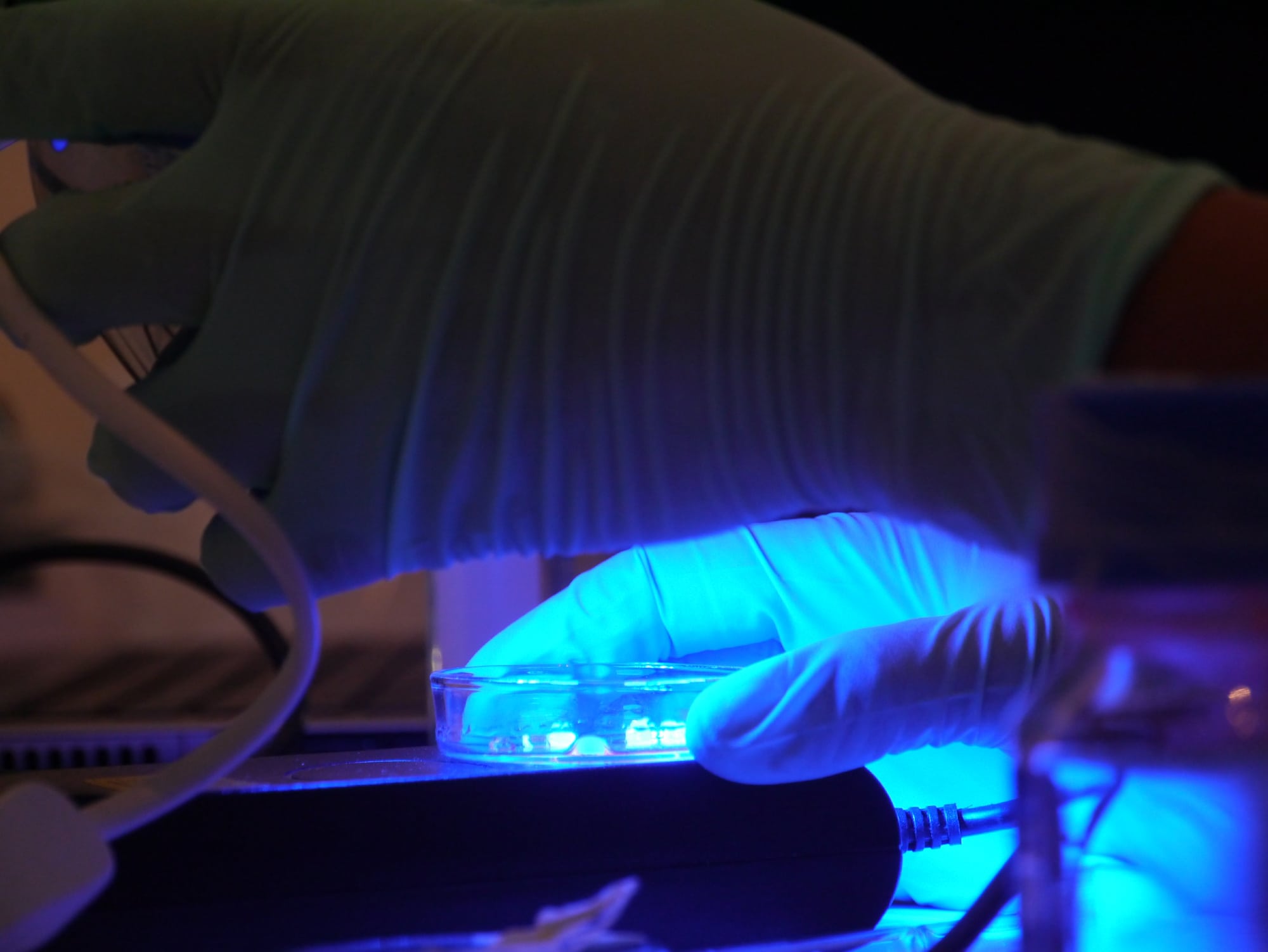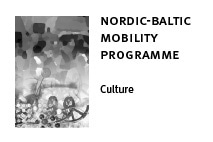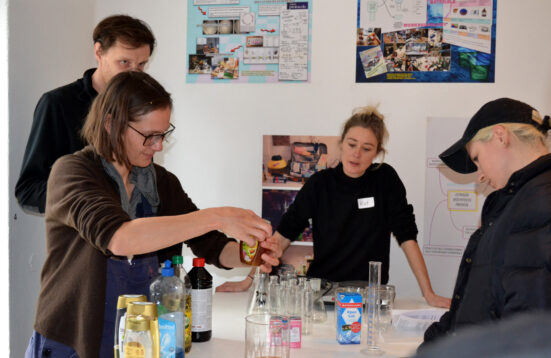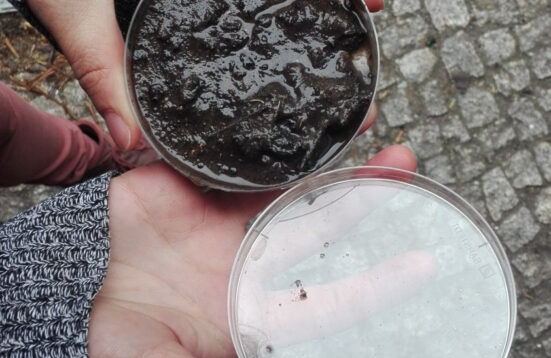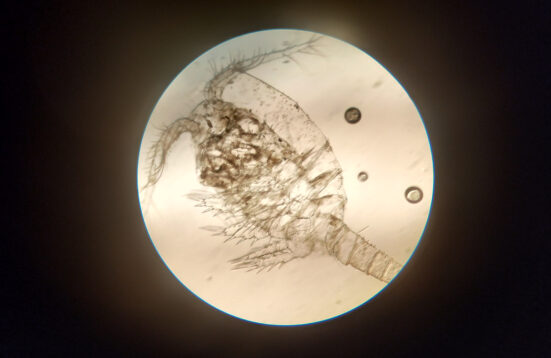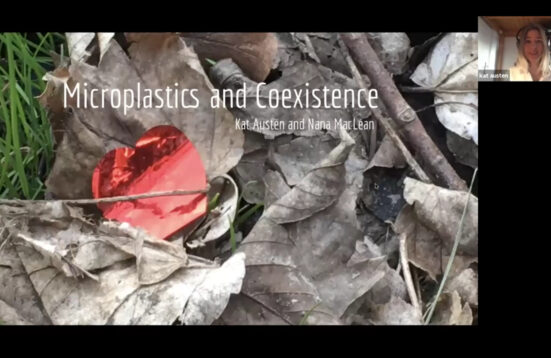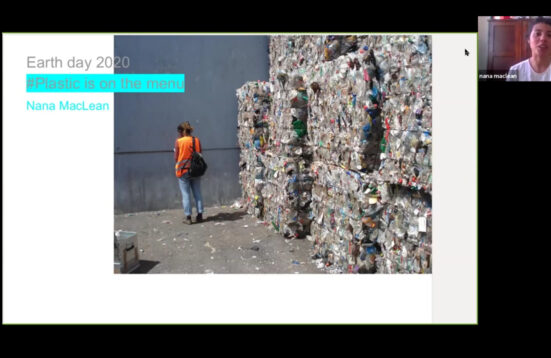DIY Hack the Panke
(Un)Real Ecologies. Microplastics | Workshop
Kat Austen and Joana MacLean
Plastic has pervaded water, soil and our bodies. It is the new icon of our time. During the (Un)Real Ecologies: Microplastics workshop explored the presence of microplastics in the Panke River, near Art Laboratory Berlin. How do organisms and microorganisms exist with and construct with these human-made materials? We interrogated the water samples, to discover a new understanding of the reality of the Panke’s ecosystem, with plastic present and wholly a part of it – a microcosm that allows us to ask “What is nature?”
The workshop
The Panke river is a small river that starts about 20 km north of Art Laboratory Berlin close to the small town of Bernau. During its way down into the city Berlin, the Panke changes into a straightened urban stream that receives rain and mixed waters from the surrounding districts. We explored two sections of the Panke, an ‘upstream’ part around ALB is bordered by parks, green shrubby watersides and a swampy floodplain. The more downstream we go, the more influenced the ecosystem will become by urban factors. The ‘downstream’ part of the Panke around Gerichtstrasse already shows less water plant vegetation than on the ‘upstream’ part. In order to collect (micro)plastic from the water stream, we placed fine nets inside the river that collected all particles flowing through that part of the Panke overnight.
To understand the status of human influence in the different parts of the Panke, we compared water from these two parts of the Panke. We searched for visible interactions between plastics and biota in and around the Panke. Asking how organisms and inhabitants of the Panke live with plastic in their habitat?
Plastics come in different shapes, textures and material properties. Their chemical properties makes them generally very resistant to natural degradation processes by fungi, algae or bacteria. However, the term plastisphere has been used by biologists to describe the living microworld attached to plastic particles in the environment. Surprisingly, plastic seems to be much more than just an human-made waste product: In marine ecosystems it was found that pieces of plastics carry a very specific community of fungi, algae and bacteria. Using a microscope, we can get a close and intimate look into their habitat. In the workshop examined the plastisphere of the Panke and observed the shapes and forms of how organisms interact with plastic. For this step, we chose some interesting particles from our catch and used the available microscopes to get a close look at plastics and living creatures.
Furthermore, we used a two step chemical protocol for the analysis of (micro) plastics in our water samples. In our case, plastics include hard plastics, soft plastics (e.g., foams), films, line, and sheets. Microplastic is defined by its size smaller than 5mm, so with our nets (200 microns) caught all sizes between 5mm and 0.2mm. During the two days of the workshop we split our samples into different groups, so that we could compare the different procedures with each other.
The solid particles in soil or waters are a mixture of minerals (abiogenic: not produced by living organisms), organic matter that are carbon-based remains from living organisms or their waste product and recently of synthesized anthropogenic compounds that find their way into both terrestrial and aquatic ecosystems.
Each of these compounds have a specific density range and will either float or sink in a given liquid column. In order to divide those three fractions from our water samples, we separated them according to their density. Using a saturated salt solution created a liquid in which plastic and minerals clearly separate from each other. But first, we needed to remove all organic compounds, leaving only minerals and plastics! Adding hydrogen peroxide solution (30%) to your sample is a common method for the elimination of organic matter as it strongly reacts with all organic carbon.
Results
– To remove all organic matter we performed a wet hydrogen peroxide oxidation (see protocols in link above). We did this in two groups: One group used a DIY protocol with a 9% hydrogen Peroxide level (due to German regulations which limit the solution strength for general sale) as well as other household chemicals to carry out the experiment. The other group used the lab protocol with 30% Hydrogen peroxide solution. Both groups were able to perform the protocols successfully. The upstream DIY samples (using H2O2 from hair dye) produced bubbles and the solution had a brownish rusty colour. Under the microscope we found few mircroplastic particles, mostly thread-like fibres. The downstream samples contained more microplastic particles, both in samples oxidised using DIY and lab protocols.
– We managed to stain plastic particles with fluorescent dye and could identify them under the microscope, separately from other abiogenic matter.
– Using coloured liquids of different densities we created a DIY density column and placed plastic particles (usually between 2-5mm in the column – see fig. 13 below). In this way we learned about how to identify different plastic types found in the environment according to their individual density.
– Additionally during the sieving process we were able to extract various flora and fauna from the Panke river. Amongst the most numerous were small (< 5mm) crustaceans, as well as various protists. A spectrum analysis of an upstream water sample is forthcoming.
-We also discussed the issue of microplastics in water from socio-cultural as well as art-science perspectives. Among the many noteworthy points we discussed plastic as another ‘banal’ carbon-based molecule (inspired by Kat’s comments). These and other points of discussion sought to open a wider public discussion on microplastics and DIY science/ DIY chemistry.
Workshop schedule
Friday, 6 July, 2018
16.30-18.30 (optional) Meet at ALB with Kat Austen and Nana MacLean and members of DIY Hack the Panke.
Placing the nets along the Panke river.
Saturday, 7 July, 2018 | Microplastics Workshop – Part I
10:00 Meet at ALB, doors open, coffee and meet / briefing & microplastic introductions with Kat and Nana
10:45 Exploration Panke and collect net samples
11:45 ALB: outline of protocols
12:00 Microscope analysis and beginning of chemical microplastic analysis
13:30 Lunch break at Panke e.V
14:30 Continue microscope analysis and chemical analysis
15:30 Creation around microscope analysis
16:00 Finishing up
Sunday, 8 July, 2018| Microplastics Workshop – Part II
9:30 Brunch at ALB
10:30 Work with samples and reactions from Saturday
10:50 DIY chemical protocol preparation
13:00 Lunch break
14:00 Last experiments and cleaning
15:30 Discussion and presentation of results
Kat Austen is a succession of experiences and an assemblage of aspirations. She creates artworks that explore multiple knowledges, from music to embodied knowledge to DIY science, focusing on emotional connections between what we consider internal and external. Kat is Cultural Fellow in Art and Science at the University of Leeds, lectures on UCL’s Arts and Sciences BASc, and is Artist in Residence in UCL’s Faculty of Maths and Physical Sciences. Previous residencies include NYU Shanghai Gallery and ArtOxygen. Kat was an inaugural member of the London Creative Network programme. She is based in Berlin.
Nana MacLean studied Biology at the UvA Amsterdam and has recently finished her Master studies in Molecular Biology at the University Potsdam. Besides her studies, she has been involved in projects that crossed borders between disciplinary styles and methods – embracing both speculative design and performative collaborations. As a PhD student, Nana is currently working on microbial communities in anthropogenic landscapes and plastic polluted grounds at the GFZ Helmholtz Center Potsdam. Her research focuses on Plastic as biological habitat, and furthermore explores future ecologies and areas of research that involve storytelling and other imaginative methodologies. Nana is based in Potsdam and Berlin.

